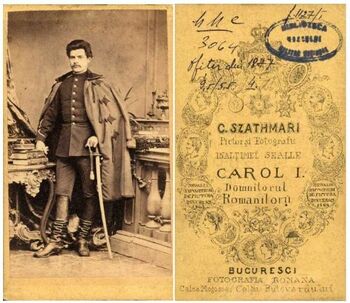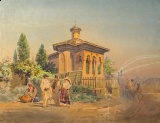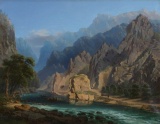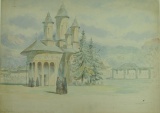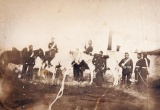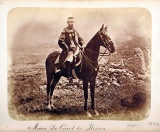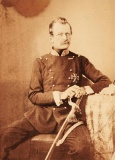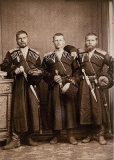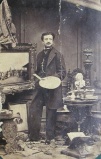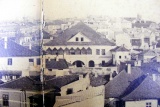Carol Szathmari
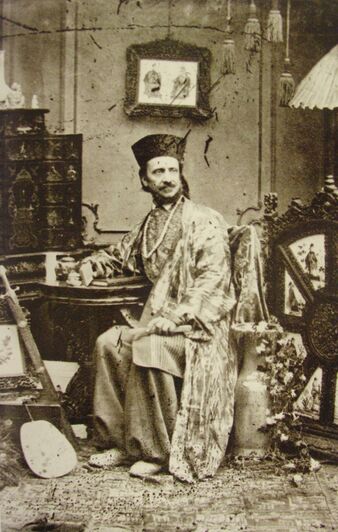 Self-portrait, c1850. | |
| Born |
January 11, 1812 Cluj, Grand Principality of Transylvania, Austrian Empire |
|---|---|
| Died |
June 3, 1887 (aged 75) Bucharest, Romania |
Carol Szathmari (Romanian: Carol Popp de Szathmary, Hungarian: Szathmáry Pap Károly, 1812-1887) was a painter, lithographer and photographer.
Contents
Early life[edit]
Before developing his inclination for photography, he studied painting and engraving, two popular arts of that period.[1]
Painting[edit]
His talent for painting shone out from an early age. Being a passionate traveller, Szathmari journeyed through Europe and often crossed the Carpathian Mountains to visit Wallachia and its capital Bucharest, where he eventually settled in 1843. An accomplished landscape and portrait painter, at ease with both watercolours and oil paints, Szathmari obtained commissions from the wealthy Wallachian boyars. Szathmari kept up constant, good relations with the successive ruling princes of Wallachia for whom he painted portraits and various other compositions.[2]
His work was later criticised in the magazine Pressa in 1898: "The Watercolors of D. Satmari (sic!) are generally lacking solidity, good up to illustrate albums, they go only as sketches and can not have any claim to serious art. Remaining works of D. Satmari be felt too much the copy of photographic studies. Their coloring is dark without light and air and gives too much lead nuances."[3]
The Crimean War[edit]
In 1848, Szathmari began to experiment with photography. The outbreak of the Russian-Ottoman War in late June 1853 saw the Romanian principalities occupied by the Russian army. In April 1854, Szathmari filled a van with his cameras and glass plates and went to the border of the Danube to document the fighting between the Russian and Turkish armies.[4]
This made him one of the first combat photographers in the battlefield (there were also Roger Fenton, William Russell, and Ludwig Angerer photographing the Crimean War).
The result of Szathmari's bravery and hard work was a photographic album. His album, containing some two hundred images, became famous due to its presentation at the 1855 Paris World Exhibition and Szathmari was awarded the Second Class Medal for his work. From that time on, photography, painting and lithography were always closely connected in Szathmari's career.[5]
Court photographer[edit]
In 1864 he became member of the Société Française de Photographie in Paris and in 1870 of the one in Vienna. In 1863, he received the title of Ruling Prince (Alexandru Ioan Cuza)'s Court Painter and Photographer which he kept for the rest of his life. The official painter followed his patron, Prince Carol I, on the battlefield during the Russian-Romanian-Ottoman War of 1877, which was waged south of the Danube.[6]
He was the first certified photographer in Romania, being also one of the first ten photographers in Europe.
Other work[edit]
Along martial compositions and albums, Szathmari had long been attracted by folk types and produced a large series of pictures with peasants, gypsies, postillions, merchants and artisans. He toured the fairs and the crowded streets of the town in search of picturesque types.[7]
He also chronicled art photography in Romania. His article entitled "Photographie Parisienne" appeared in the Viennese magazine Photographische Correspondenz in 1865.[1]
The artist's last major work was the chromolithographic album of the symbolic carts which paraded the Capital city on 10-11 May 1881, King Carol's coronation pageant.[8]
Most of his life he worked and lived in Bucharest, where he died.
Paintings[edit]
Photographs[edit]
Notes[edit]
- ↑ Bumbuţ 2009-2010, p. 81
- ↑ Ionescu 2013
- ↑ Ionescu 2008, p. 114
- ↑ Ionescu 2013
- ↑ Ionescu 2013
- ↑ Ionescu 2013
- ↑ Ionescu 2013
- ↑ Ionescu 2013
Albums[edit]
- Erdély képekben Kolósvárt : a kir. Lyceum egyesített Könyv és Kőnyomó Intézetében, [1842]. - 16 p., 94 p., [33], HTML. (Hungarian)
- Episcopie de Curtea de Arg[c]is: photographié et dédié à S. A. S. Charles 1er, prince régnant de Roumanie / par C. P. de Szathmari, peintre et photographe de Son Altesse Sérénissime, 1867 [?] - 47 p., [2]. (French)
Literature[edit]
- "Exposiţiunea Artiştilor Români în viaţă (I, II, III)". Pressa (38-40). May 1898 (Romanian).
- Ionescu, Adrian-Silvan (2008). The Official artistical mouvement in 19th century Romania, [Mişcarea oficială în România secolului al XIX-lea]. Bucharest: Noi Media Print.
- Bumbuţ, Cosmin (2009-2010). "Carol Szathmari: Partea I". Punctum (1): 78–? (Romanian).
- Ionescu, Adrian-Silvan (24 April 2013). "Szathmári, un mare artist documentarist". RIHA Journal (70) (Romanian). With English abstract.
- Emanuel Bădescu and Radu Olteanu, Carol Popp de Szathmari, fotograful Bucureştilor, Bucharest: Art Historia, 2012 [3]. (Romanian)
- Iulia Pană, ""Mici developări" din istoria artei fotografice", Datina, Serie Nouă, anul 3, nr. 22, ianuarie 2016, pp. 28-31, PDF. (Romanian)
- Iulia Pană, ""Mici developări" din istoria artei fotografice (II)", Datina, Serie Nouă, anul 3, nr. 23, februarie 2016, pp. 34-39, PDF.
See also[edit]
Links[edit]
- http://dating-au.com/szathmari-carol-popp-de-1812-1887/
- Szathmari at Wikipedia
- Szathmari at Biblioteca Academiei Române
- Szathmari at Romanian Wikipedia
- Szathmari at Hungarian Wikipedia
- First Romanian Photographers on AlexGalmeanu Blog
- Drawings by Szathmary
- images from the album Carol Popp de Szathmari, fotograful Bucureştilor
- arta vizuala, blog
- Arta din România, blog

